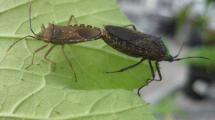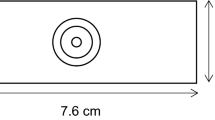Abstract
Knowledge of the reproductive ecology of insect pests is important for the development of sustainable pest control strategies. Mating behavior studies can provide insights about relevant aspects of intra- or intersexual communication processes, which may lead to sustainable control strategies based on behavioral disruption. The bronze bug, Thaumastocoris peregrinus (Hemiptera: Thaumastocoridae), is an invasive eucalypt specialist that feeds and reproduces in aggregations on eucalypt leaves, causing defoliation and branch dieback in severe infestations. Scant information is available on its mating behavior, so we here report a systematic study of male–female and male-male interactions under controlled experimental conditions. Unmated, sexually mature naive males and females were paired and videotaped from two angles to describe and quantify their behavioral interactions and transitions. Intersexual interactions included mounting, rejection, copulation, antennation and a post-copulatory behavior that we termed smearing and consisted of a rapid backward and forward movement by the male while still on top female. Antennation occurred during copulation, and it may be interpreted as copulatory courtship. Smearing occurred after copulation and positively correlates with total mating time, likely involving mate guarding. Behavioral correlations with size and age showed that female rejection is not affected by male size or age. Intrasexual interactions included two agonistic behaviors that we called sparring and riding, both likely involved in male-male competition and the establishment of male dominance in natural aggregations. Male intrasexual aggressiveness was not related to male size or age either. The results are discussed in relation to the potential functions of these behaviors in the mating system of T. peregrinus.







Similar content being viewed by others
Data Availability
Electronic Supplementary Material included.
References
Alexander RD, Marshall D, Cooley J (1997) Evolutionary perspectives on insect mating. In: Choe JC, Crespi BJ (eds) The evolution of mating system in insects and arachnids. Cambridge Press, pp 4–31
Alcock J (1994) Postinsemination associations between males and females in insects: The mate-guarding hypothesis. Annu Rev Entomol 1–21
Alkema JT, Dicke M, Wertheim B (2019) Context-dependence and the development of push-pull approaches for Integrated Management of Drosophilla suzukii. Insects 10:1–19
Arnqvist G (1988) Mate guarding and sperm displacement in the water strider Gerris lateralis Schumm. (Heteroptera: Gerridae). Freshw Biol 19:269–274
Backus EA, Serrano MS, Ranger CM (2005) Mechanisms of hopperburn: An overview of insect taxonomy, behavior, and physiology. Annu Rev Entomol 50:125–151
Brown VK (1982) Size and shape as ecological discriminants in successional communities of Heteroptera. Biol J Linn Soc 18:279–290
Calvo MV, Groba HF, Martínez G, Sellanes C, Rossini C, González A (2018) Attraction of male nymphs to adult male volatiles in the bronze bug Thaumastocoris peregrinus Carpintero and Dellape (Heteroptera: Thaumastocoridae). Neotrop Entomol 47:835–841
Carpintero DL, Dellapé PM (2006) A new species of Thaumastocoris Kirkaldy from Argentina (Heteroptera: Thaumastocoridae: Thaumastocorinae). Zootaxa 1228:61–68
Carroll SP (1991) The adaptive significance of mate guarding in the soapberry bug, Jadera haematoloma (Hemiptera: Rhopalidae). J Insect Behav 4:509–530
Carroll SP (1993) Divergence in male mating tactics between two populations of the soapberry bug: I. Guarding versus nonguarding Behav Ecol 4:156–164
Carroll SP, Loye JE (1990) Male-biased sex ratios, female promiscuity, and copulatory mate guarding in an aggregating tropical bug, Dysdercus bimaculatus. J Insect Behav 3:33–48
Chamorro-Florescano IA, Favila ME, Macías-Ordóñez R (2011) Ownership, size and reproductive status affect the outcome of food ball contests in a dung roller beetle: When do enemies share? Evol Ecol 25:277–289
Cuatianquiz C, Cordero C (2006) Experimental manipulation of male behaviour during copulation in Stenomacra marginella (Heteroptera: Largidae): Effect on copula duration, female remating and oviposition. Behav Processes 73:222–227
De Simone GA, Manrique G, Pompilio L (2018) Females’ sequential mating decisions depend on both the quality of the courting male and the quality of the potential mates in a blood-sucking bug. Behav Ecol Sociobiol. https://doi.org/10.1007/s00265-018-2560-0
Eberhard WG (1991) Copulatory courtship and cryptic female choice in insects. Bio Rev 66: 1-31
Eberhard WG (1994) Evidence for widespread courtship during copulation in 131 species of insects and spiders, and implications for cryptic female choice. Evolution (N Y) 48:711
Eberhard WG (2002) The function of female resistance behavior: Intromission by male coercion vs. female cooperation in sepsid flies (Diptera: Sepsidae). Rev Biol Trop 50:485–505
Edvardsson M, Arnqvist G (2000) Copulatory courtship and cryptic female choice in red flour beetles Tribolium castaneum. Proc R Soc B Biol Sci 267:559–563
Enquist M, Leimar O, Ljungberg T, Mallner Y, Segerdahl N (1990) A test for the sequential assessment game: fighting in the cichlid fish Nannacara anomala. Anim Behav 40: 1-14
Fairbairn DJ, Blanckenhorn WU, Székely T (2007) Sex, size and gender roles: evolutionary studies of sexual size dimorphism. Oxford University Press
Firman RC, Gasparini C, Manier MK, Pizzari T (2017) Postmating female control: 20 years of cryptic female choice. Trends Ecol Evol 32:368–382
Garcia A, Figueiredo E, Valente C, Monserrat VJ, Branco M (2013) First record of Thaumastocoris peregrinus in Portugal and of the neotropical predator Hemerobius bolivari in Europe. Bull Insectology 66:251–256
Goldsmith SK, Stewart Z, Adams S, Trimble A (1996) Body size, male aggression, and male mating success in the cottonwood borer, Plectrodera scalator (Coleoptera: Cerambycidae). J Insect Behav 9:719–727
González A, Calvo MV, Cal V, Hernández V, Doño F, Alves L, Gamenara D, Rossini C, Martínez G (2012) A male aggregation pheromone in the bronze bug, Thaumastocoris peregrinus (Thaumastocoridae). Psyche (Stuttg) 2012: ID 868474, 7 pages
Groba HF, Martínez G, Rossini C, González A (2019) Diel periodicity of 3-methyl-2-butenyl butyrate emissions by bronze bug males is suppressed in the presence of females. Neotrop Entomol 48:18–24
Harari AR, Brockmann HJ, Landolt PJ (2000) Intrasexual mounting in the beetle Diaprepes abbreviatus (L.). Proc R Soc B Biol Sci 267:2071–2079
Horton DR, Lewis TM, Thomsen-Archer K, Unruh TR (2008) Morphology, genetics, and male mating success compared between Anthocoris musculus and A. antevolens (Hemiptera: Heteroptera: Anthocoridae). Proc Entomol Soc Washingt 110:960–977
Iwahashi O, Majima T (1986) Lek formation and male-male competition in the melon fly, Dacus cucurbitae Coquillett (Diptera: Tephritidae). Appl Entomol Zool 21:70–75
Jacobs DH, Neser S (2005) Thaumastocoris australicus Kirkaldy (Heteroptera: Thaumastocoridae): a new insect arrival in South Africa, damaging to Eucalyptus trees. S Afr J Sci 101:233–236
Klingenberg CP, Zimmermann M (1992) Dyar’s rule and multivariate allometric growth in nine species of waterstriders (Heteroptera: Gerridae). J Zool 227:453–464
Lane SM, Haughan AE, Evans D, Tregenza T, House CM (2016) Same-sex sexual behaviour as a dominance display. Anim Behav 114:113–118
Lima MM, Jurberg P, Riberiso de Almeida J (1986) Behavior of Traitomines (Hemiptera: Reduviidae) vectors of Chagas’ disease. Courtship and copulation of Panstrongylus megistus (Burm., 1835) in the laboratory. Mem Inst Oswaldo Cruz 81:1–5
Lima AC V, Wilcken CF, Serrão JE, Zanuncio JC (2016) Intra-plant spatial distribution of Thaumastocoris peregrinus Carpintero and Dellapé ( Hemiptera : Thaumastocoridae ) on Eucalyptus grandis plants. Phytoparasitica
Lloyd JE (1979) Mating behavior and Natural Selection. Fla Entomol 62:17
Manrique G, Lazzari CR (1994) Sexual behaviour and stridulation during mating in Triatoma infestans (Hemiptera: Reduviidae). Mem Inst Oswaldo Cruz 89:629–633
Martínez G, López L, Cantero G, González A, Dicke M (2014) Life-history analysis of Thaumastocoris peregrinus in a newly designed mass rearing strategy. Bull Insectology 67:199–205
Martínez G, González A, Dicke M (2018) Rearing and releasing the egg parasitoid Cleruchoides noackae, a biological control agent for the Eucalyptus bronze bug. Biol Control 123:97–104
Martins CBC, Soldi RA, Barbosa LR, Aldrich JR, Zarbin PHG (2012) Volatile chemicals of adults and nymphs of the Eucalyptus pest, Thaumastocoris peregrinus (Heteroptera: Thaumastocoridae). Psyche (Stuttg) 2012: ID 275128, 6 pages
Miyatake T (1993) Male-male aggressive behavior is changed by body size difference in the leaf-footed plant bug, Leptoglossus australis, Fabricius (Heteroptera: Coreidae). J Ethol 11:63–65
Nadel RL, Noack AE (2012) Current understanding of the biology of Thaumastocoris peregrinus in the quest for a management strategy. Int J Pest Manag 58:257–266
Nadel RL, Slippers B, Scholes MC, Lawson SA, Noack AE, Wilcken CF, Bouvet JP, Wingfield MJ (2010) DNA bar-coding reveals source and patterns of Thaumastocoris peregrinus invasions in South Africa and South America. Biol Invasions 12:1067–1077
Nadel RL, Wingfield MJ, Scholes MC, Garnas JR, Lawson SA (2004) Slippers B (2015) Population dynamics of Thaumastocoris peregrinus in Eucalyptus plantations of South Africa. J Pest Sci 88:97–106
Noack AE, Cassis G, Rose HA (2011) Systematic revision of Thaumastocoris Kirkaldy (Hemiptera: Heteroptera: Thaumastocoridae). Zootaxa 60:1–60
Preston-Mafham K (2006) Post-mounting courtship and the neutralizing of male competitors through “homosexual” mountings in the fly Hydromyza livens F. (Diptera: Scatophagidae). J Nat Hist 40:101–105
R Core Development Team (2013) A language and environment for statistical computing
Rank NE, Yturralde K, Dahlhoff EP (2006) Role of contests in the scramble competition mating system of a leaf beetle. J Insect Behav 19:699–716
Ridley M (1995) Animal Behavior: An Introduction to Behavioral Mechanisms, Development, and Ecology, 2nd edn. Blackwlle Publishing
Rodriguez RL, Eberhard WG (1994) Male courtship before and during copulation in two species of Xyonysius bugs (Hemiptera, Lygaeidae). J Kansas Entomol Soc 67:37–45
Santadino M, Brentassi ME, Fanello DD, Coviella C (2017) First evidence of Thaumastocoris peregrinus (Heteroptera: Thaumastocoridae) feeding from mesophyll of Eucalyptus leaves. Environ Entomol 46:251–257
Scharf I, Martin OY (2013) Same-sex sexual behavior in insects and arachnids: prevalence, causes, and consequences. Behav Ecol Sociobiol 67:1719–1730
Schöfl G, Taborsky M (2002) Prolonged tandem formation in firebugs (Pyrrhocoris apterus) serves mate-guarding. Behav Ecol Sociobiol 52:426–433
Siva-Jothy MT (2006) Trauma, disease and collateral damage : conflict in cimicids. Philos Trans R Soc 269–275
Suma P, Nucifora S, Bella S (2014) New distribution record of the invasive bronze bug Thaumastocoris peregrinus Carpintero and Dellapé (Heteroptera, Thaumastocoridae) in Italy. EPPO Bull 44:179–182
Suzuki S, Nagano M, Trumbo ST (2005) Intrasexual competition and mating behavior in Ptomascopus morio (Coleoptera: Silphidae Nicrophorinae). J Insect Behav 18:233–242
Tsukamoto L, Kuki K, Tojo S (1994) Mating tactics and constraints in the gregarious insect Parastrachia japonensis (Hemiptera: Cydnidae). Ann Entomol Soc Am 87:962–971
Vitta ACR, Lorenzo MG (2009) Copulation and mate guarding behavior in Triatoma brasiliensis (Hemiptera: Reduviidae). J Med Entomol 46:789–795
West-Eberhard MJ (1984) Sexual selection, competitive communication and species specific signals in insects. Insect Commun 283–324
Wylie FR, Speight MR (2012) Insect pests in tropical forestry
Funding
Agencia Nacional de Investigación e Innovación (ANII), Uruguay, Grant FMV-1–2017-1–136756.
Author information
Authors and Affiliations
Corresponding authors
Ethics declarations
Conflicts of Interest
The authors declare no conflict of interest.
Supplementary Information
Below is the link to the electronic supplementary material.
Supplementary file1 (MP4 9.94 MB)
Supplementary file2 (MP4 1.64 MB)
Supplementary file 3 (MP4 12.7 MB)
Supplementary file 4 (MP4 9.93 MB)
Supplementary file 5 (MP4 9.75 MB)
Supplementary file 6 (MP4 20.0 MB)
Supplementary file 7 (MP4 7.07 MB)
Rights and permissions
About this article
Cite this article
Groba, H., Valle, D. & González, A. Intimacies of a Forest Pest: Inter- and Intrasexual Behavioral Interactions in Thaumastocoris peregrinus. J Insect Behav 34, 114–126 (2021). https://doi.org/10.1007/s10905-021-09772-2
Received:
Revised:
Accepted:
Published:
Issue Date:
DOI: https://doi.org/10.1007/s10905-021-09772-2




